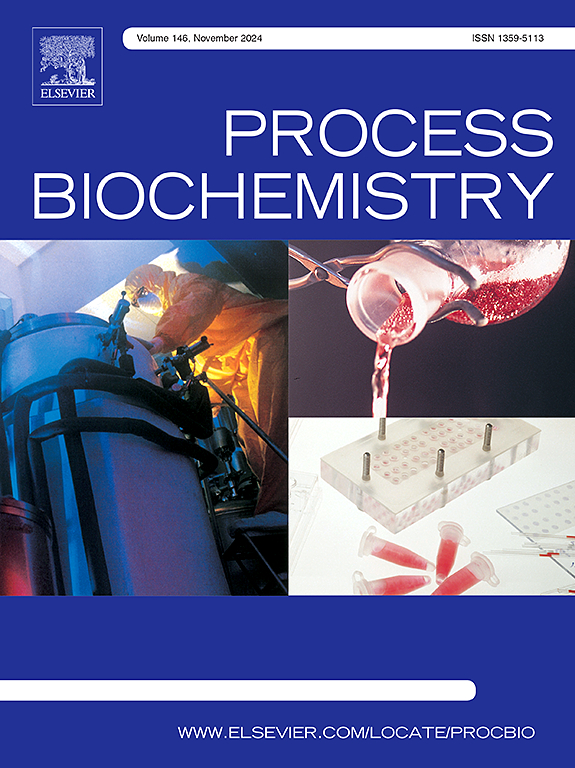Improving citric acid production in Aspergillus niger by overexpression of citrate synthase with strong promoter
IF 4
3区 生物学
Q2 BIOCHEMISTRY & MOLECULAR BIOLOGY
引用次数: 0
Abstract
Aspergillus niger CGMCC10142, a strain widely used for industrial citric acid (CA) production, encodes four citrate synthase genes (cs1-cs4), yet their specific roles in CA biosynthesis remain poorly understood. We found that the transcript levels of the genes encoding mitochondrial citrate synthases, cs3 or cs4 were significantly higher than those encoding cytoplasmic citrate synthases cs1 and cs2 with 94.26–766.0 folds or 219.33–1782.25 folds, from 27.8 (cs2) to 49546.6 (cs4) at 24 h during CA fermentation. Given the naturally low transcription levels and cytoplasmic localization of cs1 and cs2, we hypothesized that their overexpression would enhance CA production by increasing the CA available for export. Transformants overexpressing cytoplasmic cs1 (T-c1–19) and cs2 (T-c2–81) showed increases in CA production of 5.38 % and 18.39 %, respectively. In contrast, no significant change was observed in transformant overexpressing mitochondrial cs3 (T-c3–11). The results showed a 6.8 % increase in acid production by strain T-c2–81, reaching 181.2 g/L at 56 h in 30 L bioreactors, compared to the starting strain of 169.6.g/L. qRT-PCR analysis of revealed that the relative expression levels of cs2 in the T-c2–81 strain was 8.6 times higher than in the wild-type strain at 24 h. In addition, the expression levels of key genes pfk, pc and the citrate transporter cexA were significantly increased, ranging from 1.3 to 67 times than the control levels. This 6.8 % improvement of CA yield not only reduces unit fermentation costs but also represents a significant breakthrough in regulating intracellular metabolic flow.
利用强启动子柠檬酸合成酶过表达提高黑曲霉柠檬酸产量
黑曲霉CGMCC10142是一种广泛用于工业柠檬酸(CA)生产的菌株,它编码四个柠檬酸合成酶基因(cs1-cs4),但它们在CA生物合成中的具体作用尚不清楚。我们发现,在24 h CA发酵过程中,编码线粒体柠檬酸合成酶cs3和cs4的基因转录量显著高于编码细胞质柠檬酸合成酶cs1和cs2的基因转录量,分别为94.26-766.0倍和219.33-1782.25倍,从27.8 (cs2)到49546.6 (cs4)。考虑到cs1和cs2的天然低转录水平和细胞质定位,我们假设它们的过表达会通过增加可供出口的CA来促进CA的产生。过表达细胞质cs1 (T-c1-19)和cs2 (T-c2-81)的转化子的CA产量分别增加了5.38% %和18.39% %。相比之下,转染过表达线粒体cs3 (T-c3-11)未见明显变化。结果表明,菌株T-c2-81在30 L的生物反应器中,在56 h时产酸量达到181.2 g/L,比初始菌株169.6 g/L提高了6.8 %。qRT-PCR分析显示,在24 h时,T-c2-81菌株cs2的相对表达量是野生型菌株的8.6倍。此外,关键基因pfk、pc和柠檬酸转运蛋白cea的表达量显著升高,为对照水平的1.3 ~ 67倍。6.8% %的CA产量提高不仅降低了单位发酵成本,而且在调节细胞内代谢流方面也取得了重大突破。
本文章由计算机程序翻译,如有差异,请以英文原文为准。
求助全文
约1分钟内获得全文
求助全文
来源期刊

Process Biochemistry
生物-工程:化工
CiteScore
8.30
自引率
4.50%
发文量
374
审稿时长
53 days
期刊介绍:
Process Biochemistry is an application-orientated research journal devoted to reporting advances with originality and novelty, in the science and technology of the processes involving bioactive molecules and living organisms. These processes concern the production of useful metabolites or materials, or the removal of toxic compounds using tools and methods of current biology and engineering. Its main areas of interest include novel bioprocesses and enabling technologies (such as nanobiotechnology, tissue engineering, directed evolution, metabolic engineering, systems biology, and synthetic biology) applicable in food (nutraceutical), healthcare (medical, pharmaceutical, cosmetic), energy (biofuels), environmental, and biorefinery industries and their underlying biological and engineering principles.
 求助内容:
求助内容: 应助结果提醒方式:
应助结果提醒方式:


